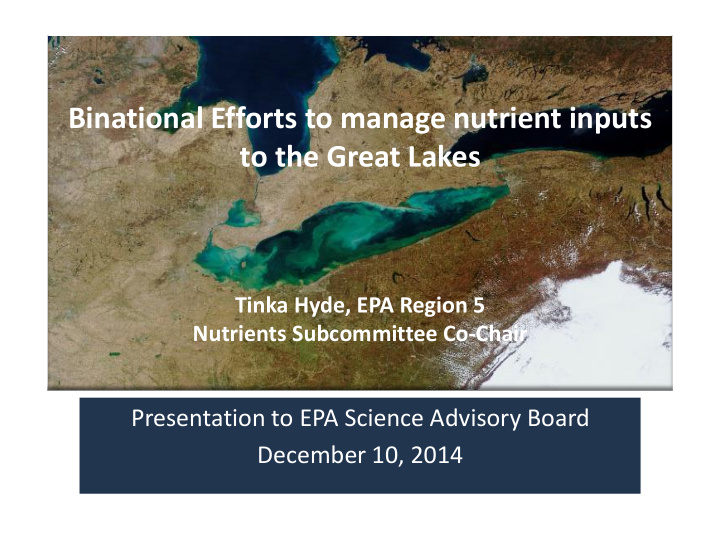



Binational Efforts to manage nutrient inputs to the Great Lakes Tinka Hyde, EPA Region 5 Nutrients Subcommittee Co-Chair Presentation to EPA Science Advisory Board December 10, 2014
Harmful and Nuisance Algal Blooms …it’s not a new problem • Blooms were a significant problem in Lakes Erie, Ontario and Huron in the 1960s and 1970s. – Environmentalists declared Lake Erie “dead” • The algae issue was a major driver for the signing of the first Canada-United States Great Lakes Water Quality Agreement in 1972 – The Agreement established binational targets for the reduction of phosphorus discharges to the Great Lakes • Governments responded by regulating phosphorus in detergents, investing in sewage treatment, and developing and promoting best management practices for agriculture lands.
Harmful and Nuisance Algal Blooms …have been increasing in Lake Erie since late 1990’s Causes and Sources: • nutrient (especially phosphorus but also nitrogen) discharges from urban and agricultural landscapes due to changes in land use and land management practices and population growth • increased frequency of severe storms • changes to water clarity and nutrient flows caused by Aquatic Invasive Species (Zebra and Quagga Mussels) • increased temperatures • longer growing seasons
The 2012 GLWQA includes commitments to develop new phosphorus targets and action plans Starting with Lake Erie by 2016 • Determine phosphorus concentration objectives and loading targets for open waters and nearshore areas including embayment's and tributaries • Determine loading allocation by country and identify priority watersheds for load reduction Starting with Lake Erie by 2018 • Assess effectiveness of programs to achieve the Substance and Lake Ecosystem Objectives • Develop domestic action plans and strategies to control nutrients
Subcommittee and Task Group Structure Core Team Tinka Hyde, EPA Annex Subcommittee Susan Humphrey, EC Sandra George, EC Santina Wortman, EPA Agricultural Objectives and Targets Urban and Rural Development Municipal Sources Sources John Schlichter, Ohio William Creal, Michigan Jeffrey Reutter, Ohio Dept. of Agriculture Dept. of Environmental Sea Grant Quality Jim Richardson, Sandra George, Ontario Ministry of Terri Bulman, Ontario Environment Canada Agriculture Ministry of the Environment 5
Draft Phosphorus Reduction Strategy Components Possible Components • Context and Background • Phosphorus Objectives and Targets Loading allocations by country Identification of Priority Watersheds • Planning & Progress Short-term: Interim Action Plans under discussion Long-term: Domestic Action • Adaptive Management To manage uncertainty Respond to new information 6
Targets & Objectives • Ensemble modeling used to establish targets and objectives • Modeling directly linked to achieving Lake Ecosystem Objectives (paraphrased from agreement) Maintain healthy nearshore and offshore algal communities Algal biomass does not pose nuisance conditions Reduce extent of hypoxic zones associated with algal blooms, Cyanobacteria toxins do not pose human health risk Maintain mesotrophic conditions in Western Basin and Central Basin Maintain oligotrophi c conditions in Eastern Basin *Note: The bolded terms are being defined 7
Eutrophication Models Response Indicators Eastern Overall Western Basin Central Model Basin phytoplankton cyanobacteria Basin Cladophora biomass blooms hypoxia (nearshore) NOAA Western Lake Erie HABs (Stumpf) X U-M/GLERL Western Lake Erie HABs (Obenour) X TP Mass Balance Model (Chapra, Dolan, and X Dove) 1-D Central Basin Hypoxia Model (Rucinski) X X Ecological Model of Lake Erie (EcoLE) (Zhang) X X 9Box model (McCrimmon, Leon, and Yerubandi) X Western Lake Erie Ecosystem Model X X (LimnoTech) ELCOM-CAEDYM (Bocaniov, Leon, and X X Yerubandi) Great Lakes Cladophora model (Auer) X 8
Schedule DRAFT P Reduction Strategy and Targets - Tasks Timeline USEPA Science Advisory Board Peer Review of in progress Technical Approach (Phase 1) Draft Targets & Objectives to GLEC Co-Chairs April 2015 USEPA SAB Peer Review (Phase 2) ~June – August 2015 Public Engagement on the targets using the draft ~June - August 2015 P Reduction Strategy, and on the draft binational program evaluation criteria Consideration of public engagement input and ~September – November 2015 adjust the targets and criteria as appropriate Final draft Targets & Objectives to GLEC ~ December 2015 Proposed Targets & Objectives ~February 2016 9
USEPA Science Advisory Board (SAB) Peer Review Phase I Consultation on the Draft Technical Approach for Lake Erie Phosphorus Load-Response Modeling 1. Do the Eutrophication Response Indicators proposed sufficiently address and provide scientific foundation for the Lake Ecosystem Objectives for Lake Erie? 2. Are the models chosen appropriate for representing eutrophication response in Lake Erie? Do they reflect the best available scientific knowledge? 3. Are the models sufficient to provide a scientifically grounded basis for phosphorus load targets for Lake Erie? 4. How can we ensure the P concentration and loading targets are internally consistent with respect to the eutrophication response indicators of concern? Phase II Peer Review will occur in 2015 10
Acknowledgements • Thomas Carpenter, Chris Zarba and the SAB panel • Jan Ciborowski, George Arhonditsis, William Taylor, Murray Charleton, and Douglas Haffner for serving as technical advisors to the panel • Great Lakes Program Office – Paul Horvatin and staff for technical and logistical support • Our federal and state partners, esp NOAA and Environment Canada • The modeling team, led by Harry Stone of Battelle, Joseph DePinto of Limnotech, and Donald Scavia of University of Michigan • The Objectives and Targets Task Group, particularly Jeffrey Reutter and Sandra George for their leadership Your contributions are greatly appreciated!
Recommend
More recommend